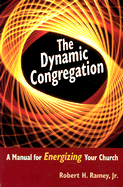Does this sound like your experience of church?
Little seems to happen during church services. You eat this bread and drink the wine at communion, even hear in the liturgy that Christ is present, but everyone seems bored. . . . You call nine people before finding a volunteer to take a meal to a senior citizen. So you mutter at the end of the day, “Is this all our church is ever going to be? This church has no power. Little seems to be happening here.†(p. xi)
If this sounds too depressingly familiar, then Robert H. Ramey, Jr.’s book, The Dynamic Congregation: A Manual for Energizing Your Church (St. Louis, MO: Chalice Press, 1999) may be for you.

Ramey reminds his readers that the same power of the Holy Spirit that Jesus promised to his disciples (Acts 1:8) is still available to us today. Churches, and church leaders, have forgotten the source of their power in the Spirit, Ramey asserts. Churches need to reclaim that source and allow it to renew their “being, doing, telling and celebrating†(p. xiv).
The book is structured according to the four basic functions of a congregation that, when practiced, make the congregation an authentic community of the Holy Spirit: Fellowship, Service, Proclamation and Celebration. Two chapters cover each of the four and a ninth chapter attempts to demonstrate how these functions can connect in small groups. Throughout the book, the reader is referred to one of each of the eight appendices grouped together at the end of the book. The eight appendices consist of sample surveys and handouts that can be used in the various revitalization programs covered in the book. These can be readily adapted to fit any congregation’s particular context and need.
Each chapter presents the practical discussion of revitalization in each function as occurring in discussions at a hypothetical “Redeemer Church,†which is described as a slowly growing church of 350 members in a small city of 50,000. Ramey claims that the issues raised in each chapter are found in all churches and contexts and thus translate readily across the spectrum.
In the chapter on Nurture (which in his scheme comes under the “Proclamation†function), Ramey discusses Christian education and the teaching of the Christian faith. In assessing the context and condition of Christian education today, he wrote, “the Sunday school itself cannot bear the entire weight of the congregation’s teaching responsibility†(p. 57). He proposes a much more holistic view of education, realizing that everything the congregation does, teaches (a concept that should sound familiar to readers of the GRACE blog!).
Ramey’s is not a perfect book, and not the silver bullet for church revitalization. But he treats the topic responsibly. Ramey presents a good balance between the practical and theoretical in treating his topic. The extensive footnotes lead the reader to a rich resource of additional readings on the topics covered. The topic of church revitalization is more complex than any one book can treat, given that the multi-varied context, type, and particulars of congregations means that what constitutes “revitalization†needs to be almost defined for ever individual congregation at any given point in its history. But Ramey’s book is a worthwhile resource for those passionate enough to want to be the church be the best it can be.


Pingback: Book Reviews